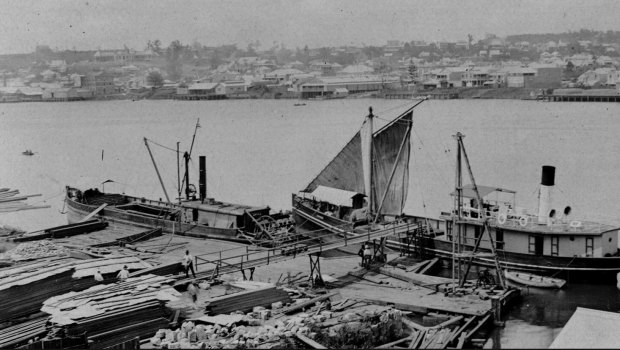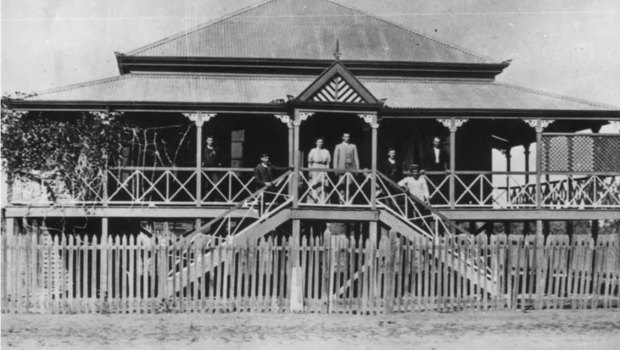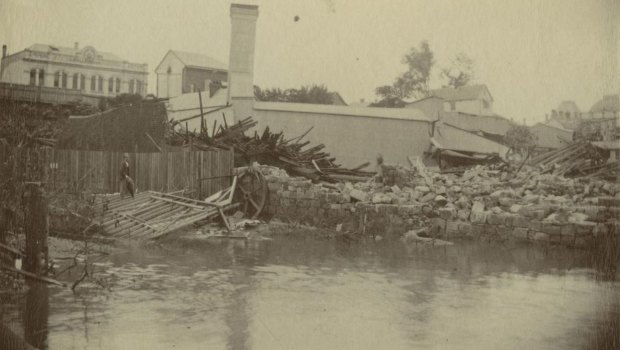This was published 7 years ago
Was the first Queenslander-style home born at 1 William Street?
By Tony Moore
Brisbane’s first Queenslander homes were created with cheap timber cut and prepared by a famous sawmill and timber yards on a site that now rests in the shadow of 1 William Street.
The sawmill stretched along the river to where the Queensland University of Technology is today and the home of its owner, William Pettigrew, was where the state government's "Tower of Power" stands.

Wiliam Pettigrew's sawmills at Queens Wharf in Brisbane.Credit: John Oxley Library Brisbane.
Some historians say the mill was where the Neville Bonner Building once stood.
Pettigrew, a Scotsman who arrived in Brisbane in 1849, was “recruited” by controversial religious figure John Dunmore Lang, who was also promoting the separation of the new Queensland colony.
Lang had wanted to call Queensland “Cooksland”, after British Royal Navy captain and explorer Sir James Cook.
Pettigrew, a Presbyterian church elder and later a magistrate, opened his William Street steam sawmill in 1853, four years after arriving at Queens Wharf.
He became a pioneer of Queensland’s timber industry, his teams felling trees, lashing logs together and floating them down rivers to be cut and fashioned into timber for homes.
Queensland government historian Harold Thornton, of the Department of State Development, tells how Pettigrew battled floods, fires, riches, debt and time as one of Brisbane’s earliest councillors to make a lasting impression on the city.
“Pettigrew, born in Scotland in 1825, was one of the god-fearing free settlers recruited by Dr John Dunmore Lang to arrive in Brisbane on the Fortitude in 1849,” he said.
“Pettigrew’s training as a surveyor came in handy in the colony, since the land had to be subdivided if a free settler population was to be attracted and supported.
“Much of the original cadastral surveying of Brisbane was Pettigrew’s work – from Ipswich east along the Brisbane River to Moggill, south to Mount Gravatt, and further east to Cleveland.”
“At this time Brisbane boasted large stands of mature furniture species like Queensland red cedar (Toona ciliata), Queensland maple (Flindersia brayleyana) and silky oak (Grevillea robusta), as well as structural softwoods like Moreton Bay (hoop) pine (Araucaria cunninghamii) and numerous hardwood species like narrow-leafed ironbark (Eucalyptus crebra) and other eucalypt species.”
“Transportation of sawlogs was an issue, since the colony’s roads were primitive.
“The Brisbane River made movement of the massive logs possible. They were tied into rafts and floated down to Pettigrew’s when tides and river currents allowed. Rafting Ground Park at Brookfield, where Moggill Creek meets the Brisbane River, was one of the points where logs were gathered and lashed together.”
When the logs arrived at Pettigrew’s sawmill they were “selected to meet orders and market demand, hoisted out of the water on dollies and fed straight into the mill”.
Eventually timber yards and small rail lines ran along much of this riverside area, Dr Thornton said.
Despite Pettigrew’s large influence in social and political circles, his biggest impact on Queensland was his contribution to the timber industry.
“Pettigrew’s true legacy ... is in his pioneering production of high-quality, inexpensive construction timber to create Australia’s most distinctive and functional architectural form – the Queenslander,” Dr Thornton said.

An early Queenslander from the 1880s, built off the ground to keep cool and clear of floodwaters, with its wide verandahs and high roof.Credit: John Oxley Library
The Queenslander building style, with wide timber verandahs and pitched roofs, began to emerge in the mid-to-late 1800s and remained popular until WWII.
Pettigrew's sawmill at Queens Wharf was “new technology” of its day, a steam sawmill that allowed more timber to be cut faster and more efficiently than could be done by two men with a manual cross-cut saw.
Timber waste provided fuel for the steam boilers.
“With steam, water could be pumped, backbreaking toil made easy and complex machines given life,” Dr Thornton said.
Running a sawmill on the Brisbane River’s edge was complex.
“Factors such as abundance of fuel, bacterial fermentation of sawdust heaps, deliberate fires getting out of hand and lack of firefighting infrastructure caused several major fires at the sawmill,” Dr Thornton said.
“Floods were another hazard for the riverside business. Despite this, the mill was a commercial success and encouraged the ambitious Pettigrew to expand,” he said.
“He opened mills at Maryborough, Maroochydore and Gympie based on forests he had also acquired.
“Pettigrew even built Queensland’s first private railway – the Cooloola line – and ordered the colony’s first locomotive built at Walker’s in Maryborough to Pettigrew’s own design.”
Other companies built small rail lines connecting properties along Queens Wharf.
William Pettigrew’s timber businesses expanded.
“The range of timber products on offer also expanded to include fancy mouldings and architraves, joinery and even fine cabinet making. A good example, an elaborate davenport with marquetry face, is held in the Queensland Women’s Historical Society headquarters at Miegunyah in Bowen Hills.”
He established the Royal National Association, served as a councillor for 18 years, as mayor in 1870 and eventually in 1877 a member of Queensland’s Legislative Council.
The 1893 Brisbane flood destroyed his business.

Pettigrew's sawmill flooded and destroyed in the 1893 floods.Credit: John Oxley Library, Brisbane.
“It all came crashing down in 1893, where a combination of fire, economic slump, bank collapses and the worst-ever floods in south-east Queensland ruined William Pettigrew and closed the mill,” Dr Thornton said.
Pettigrew died in 1906.
The William Street sawmill site was acquired by the Queensland government and eventually bequeathed to the University of Queensland as its first campus in 1909.
William Pettigrew’s house was preserved as a heritage building.
Sadly it was demolished in 1970 to make way for the Alice Street on-ramp to the South East Freeway.
This is the fifth in a series of weekly "little Brisbane histories" to be run by Fairfax Media as the Queen's Wharf development evolves.